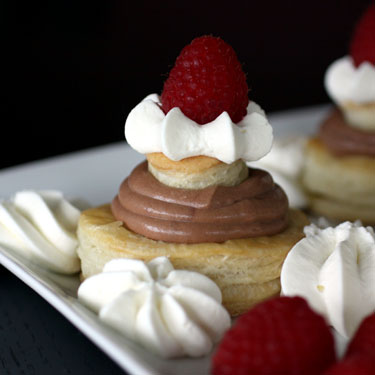 The September 2009 Daring Bakers’ challenge was hosted by Steph of A Whisk and a Spoon. She chose the French treat, Vols-au-Vent based on the Puff Pastry recipe by Michel Richard from the cookbook Baking With Julia by Dorie Greenspan.
The September 2009 Daring Bakers’ challenge was hosted by Steph of A Whisk and a Spoon. She chose the French treat, Vols-au-Vent based on the Puff Pastry recipe by Michel Richard from the cookbook Baking With Julia by Dorie Greenspan.
Puff pastry is why I joined the Daring Bakers.
I was ecstatic when I saw that this month’s Daring Bakers’ challenge was to make homemade puff pastry. Puff pastry has been on my must-make list for a very long time, but I never seemed to get around to it. Knowing that I had to make it for the challenge was the little push that I needed to make the time so that I could cross puff pastry off of the list!
Overall, I was pretty happy with how my vols-au-vent turned out. They didn’t puff up quite as much as I would have liked – I think I may have rolled the dough a bit too thin. Even so, they were absolutely delicious!
I made two sizes – large vols-au-vent filled with my cranberry almond chicken salad, and smaller vols-au-vent filled with chocolate mousse and topped with whipped cream and raspberries. I especially loved the ones filled with the chocolate mousse, and made them dessert again a few nights later to take to our friends’ house.
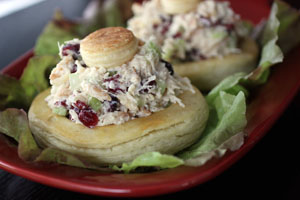
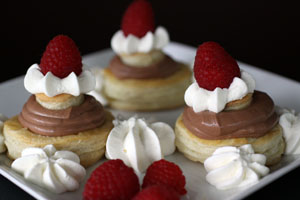
Here is the original recipe that was posted for the challenge. Give it a try and I’m sure you’ll find the vols-au-vent to be as amazing as I did.
Equipment:
- Food processor (will make mixing dough easy, but I imagine this can be done by hand as well)
- Rolling pin
- Pastry brush
- Metal bench scraper (optional, but recommended)
- Plastic wrap
- Baking sheet
- Parchment paper
- Silicone baking mat (optional, but recommended)
- Set of round cutters (optional, but recommended)
- Sharp chef’s knife
- Fork
- Oven
- Cooling rack
Prep Times:
- About 4-5 hours to prepare the puff pastry dough (much of this time is inactive, while you wait for the dough to chill between turns…it can be stretched out over an even longer period of time if that better suits your schedule)
- About 1.5 hours to shape, chill and bake the vols-au-vent after your puff pastry dough is complete
Michel Richard’s Puff Pastry Dough
From: Baking with Julia by Dorie Greenspan
Yield: 2-1/2 pounds dough
Steph’s note: This recipe makes more than you will need for the quantity of vols-au-vent stated above. While I encourage you to make the full recipe of puff pastry, as extra dough freezes well, you can halve it successfully if you’d rather not have much leftover.
- 2-1/2 cups (12.2 oz/ 354 g) unbleached all-purpose flour
- 1-1/4 cups (5.0 oz/ 142 g) cake flour
- 1 tbsp. salt (you can cut this by half for a less salty dough or for sweet preparations)
- 1-1/4 cups (10 fl oz/ 300 ml) ice water
- 1 pound (16 oz/ 454 g) very cold unsalted butter
- Extra flour for dusting work surface
Mixing the Dough:
Check the capacity of your food processor before you start. If it cannot hold the full quantity of ingredients, make the dough into two batches and combine them.
Put the all-purpose flour, cake flour, and salt in the work bowl of a food processor fitted with a metal blade and pulse a couple of times just to mix. Add the water all at once, pulsing until the dough forms a ball on the blade. The dough will be very moist and pliable and will hold together when squeezed between your fingers. (Actually, it will feel like Play-Doh.)
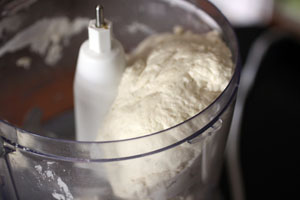
Remove the dough from the machine, form it into a ball, with a small sharp knife, slash the top in a tic-tac-toe pattern. Wrap the dough in a damp towel and refrigerate for about 5 minutes.
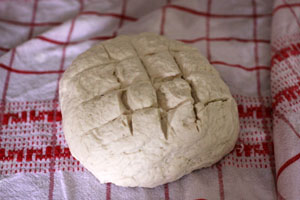
Meanwhile, place the butter between 2 sheets of plastic wrap and beat it with a rolling pin until it flattens into a square that’s about 1″ thick. Take care that the butter remains cool and firm: if it has softened or become oily, chill it before continuing.
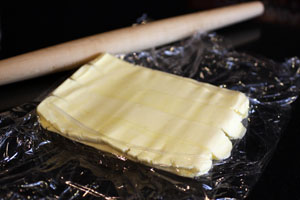
Incorporating the Butter:
Unwrap the dough and place it on a work surface dusted with all-purpose flour (A cool piece of marble is the ideal surface for puff pastry) with your rolling pin (preferably a French rolling pin without handles), press on the dough to flatten it and then roll it into a 10″ square. Keep the top and bottom of the dough well floured to prevent sticking and lift the dough and move it around frequently. Starting from the center of the square, roll out over each corner to create a thick center pad with “ears,” or flaps.
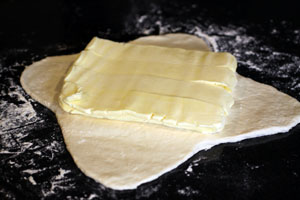
Place the cold butter in the middle of the dough and fold the ears over the butter, stretching them as needed so that they overlap slightly and encase the butter completely. (If you have to stretch the dough, stretch it from all over; don’t just pull the ends) you should now have a package that is 8″ square.
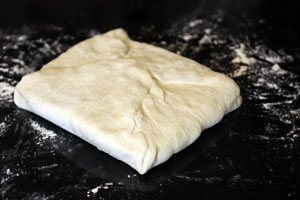
To make great puff pastry, it is important to keep the dough cold at all times. There are specified times for chilling the dough, but if your room is warm, or you work slowly, or you find that for no particular reason the butter starts to ooze out of the pastry, cover the dough with plastic wrap and refrigerate it . You can stop at any point in the process and continue at your convenience or when the dough is properly chilled.
Making the Turns:
Gently but firmly press the rolling pin against the top and bottom edges of the square (this will help keep it square). Then, keeping the work surface and the top of the dough well floured to prevent sticking, roll the dough into a rectangle that is three times as long as the square you started with, about 24″ (don’t worry about the width of the rectangle: if you get the 24″, everything else will work itself out.) With this first roll, it is particularly important that the butter be rolled evenly along the length and width of the rectangle; check when you start rolling that the butter is moving along well, and roll a bit harder or more evenly, if necessary, to get a smooth, even dough-butter sandwich (use your arm-strength!).
With a pastry brush, brush off the excess flour from the top of the dough, and fold the rectangle up from the bottom and down from the top in thirds, like a business letter, brushing off the excess flour. You have completed one turn.
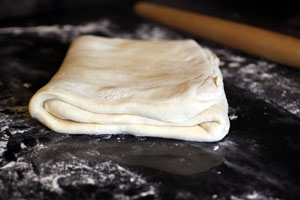
Rotate the dough so that the closed fold is to your left, like the spine of a book. Repeat the rolling and folding process, rolling the dough to a length of 24″ and then folding it in thirds. This is the second turn.
Chilling the Dough:
If the dough is still cool and no butter is oozing out, you can give the dough another two turns now. If the condition of the dough is iffy, wrap it in plastic wrap and refrigerate it for at least 30 minutes. Each time you refrigerate the dough, mark the number of turns you’ve completed by indenting the dough with your fingertips. It is best to refrigerate the dough for 30 to 60 minutes between each set of two turns.
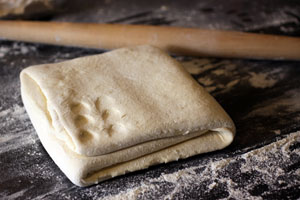
The total number of turns needed is six. If you prefer, you can give the dough just four turns now, chill it overnight, and do the last two turns the next day. Puff pastry is extremely flexible in this regard. However, no matter how you arrange your schedule, you should plan to chill the dough for at least an hour before cutting or shaping it.
Forming and Baking the Vols-au-Vent
Yield: 1/3 of the puff pastry recipe below will yield about 8-10 1.5” vols-au-vent or 4 4” vols-au-vent
In addition to the equipment listed above, you will need:
- Well-chilled puff pastry dough (recipe below)
- Egg wash (1 egg or yolk beaten with a small amount of water)
- Your filling of choice
Line a baking sheet with parchment and set aside.
Using a knife or metal bench scraper, divided your chilled puff pastry dough into three equal pieces. Work with one piece of the dough, and leave the rest wrapped and chilled. (If you are looking to make more vols-au-vent than the yield stated above, you can roll and cut the remaining two pieces of dough as well…if not, then leave refrigerated for the time being or prepare it for longer-term freezer storage. See the “Tips” section below for more storage info.)
On a lightly floured surface, roll the piece of dough into a rectangle about 1/8 to 1/4-inch (3-6 mm) thick. Transfer it to the baking sheet and refrigerate for about 10 minutes before proceeding with the cutting.
(This assumes you will be using round cutters, but if you do not have them, it is possible to cut square vols-au-vents using a sharp chef’s knife.) For smaller, hors d’oeuvre sized vols-au-vent, use a 1.5” round cutter to cut out 8-10 circles. For larger sized vols-au-vent, fit for a main course or dessert, use a 4” cutter to cut out about 4 circles. Make clean, sharp cuts and try not to twist your cutters back and forth or drag your knife through the dough. Half of these rounds will be for the bases, and the other half will be for the sides. (Save any scrap by stacking—not wadding up—the pieces…they can be re-rolled and used if you need extra dough. If you do need to re-roll scrap to get enough disks, be sure to use any rounds cut from it for the bases, not the ring-shaped sides.)
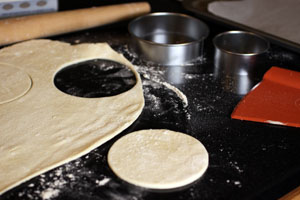
Using a ¾-inch cutter for small vols-au-vent, or a 2- to 2.5-inch round cutter for large, cut centers from half of the rounds to make rings. These rings will become the sides of the vols-au-vent, while the solid disks will be the bottoms. You can either save the center cut-outs to bake off as little “caps” for you vols-au-vent, or put them in the scrap pile.
Dock the solid bottom rounds with a fork (prick them lightly, making sure not to go all the way through the pastry) and lightly brush them with egg wash. Place the rings directly on top of the bottom rounds and very lightly press them to adhere. Brush the top rings lightly with egg wash, trying not to drip any down the sides (which may inhibit rise). If you are using the little “caps,” dock and egg wash them as well.
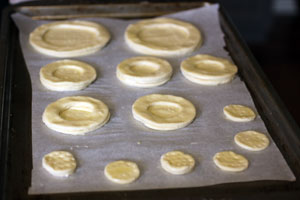
Refrigerate the assembled vols-au-vent on the lined baking sheet while you pre-heat the oven to 400ºF (200ºC). (You could also cover and refrigerate them for a few hours at this point.)
Once the oven is heated, remove the sheet from the refrigerator and place a silicon baking mat (preferred because of its weight) or another sheet of parchment over top of the shells. This will help them rise evenly. Bake the shells until they have risen and begin to brown, about 10-15 minutes depending on their size. Reduce the oven temperature to 350ºF (180ºC), and remove the silicon mat or parchment sheet from the top of the vols-au-vent. If the centers have risen up inside the vols-au-vent, you can gently press them down. Continue baking (with no sheet on top) until the layers are golden, about 15-20 minutes more. (If you are baking the center “caps” they will likely be finished well ahead of the shells, so keep an eye on them and remove them from the oven when browned.)
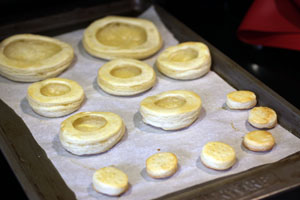
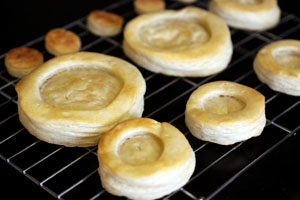
Remove to a rack to cool. Cool to room temperature for cold fillings or to warm for hot fillings.
Fill and serve.
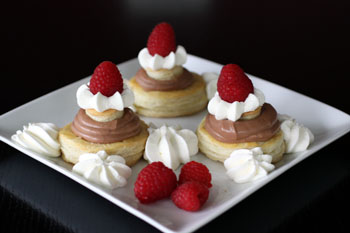
*For additional rise on the larger-sized vols-au-vents, you can stack one or two additional ring layers on top of each other (using egg wash to “glue”). This will give higher sides to larger vols-au-vents, but is not advisable for the smaller ones, whose bases may not be large enough to support the extra weight.
*Although they are at their best filled and eaten soon after baking, baked vols-au-vent shells can be stored airtight for a day.
*Shaped, unbaked vols-au-vent can be wrapped and frozen for up to a month (bake from frozen, egg-washing them first).
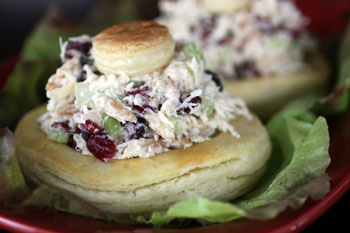
Steph’s extra tips:
-While this is not included in the original recipe we are using (and I did not do this in my own trials), many puff pastry recipes use a teaspoon or two of white vinegar or lemon juice, added to the ice water, in the détrempe dough. This adds acidity, which relaxes the gluten in the dough by breaking down the proteins, making rolling easier. You are welcome to try this if you wish.
-Keep things cool by using the refrigerator as your friend! If you see any butter starting to leak through the dough during the turning process, rub a little flour on the exposed dough and chill straight away. Although you should certainly chill the dough for 30 to 60 minutes between each set of two turns, if you feel the dough getting to soft or hard to work with at any point, pop in the fridge for a rest.
-Not to sound contradictory, but if you chill your paton longer than the recommended time between turns, the butter can firm up too much. If this seems to be the case, I advise letting it sit at room temperature for 5-10 minutes to give it a chance to soften before proceeding to roll. You don’t want the hard butter to separate into chuncks or break through the dough…you want it to roll evenly, in a continuous layer.
-Roll the puff pastry gently but firmly, and don’t roll your pin over the edges, which will prevent them from rising properly. Don’t roll your puff thinner than about about 1/8 to 1/4-inch (3-6 mm) thick, or you will not get the rise you are looking for.
-Try to keep “neat” edges and corners during the rolling and turning process, so the layers are properly aligned. Give the edges of the paton a scooch with your rolling pin or a bench scraper to keep straight edges and 90-degree corners.
-Brush off excess flour before turning dough and after rolling.
-Make clean cuts. Don’t drag your knife through the puff or twist your cutters too much, which can inhibit rise.
-When egg washing puff pastry, try not to let extra egg wash drip down the cut edges, which can also inhibit rise.
-Extra puff pastry dough freezes beautifully. It’s best to roll it into a sheet about 1/8 to 1/4-inch thick (similar to store-bought puff) and freeze firm on a lined baking sheet. Then you can easily wrap the sheet in plastic, then foil (and if you have a sealable plastic bag big enough, place the wrapped dough inside) and return to the freezer for up to a few months. Defrost in the refrigerator when ready to use.
-You can also freeze well-wrapped, unbaked cut and shaped puff pastry (i.e., unbaked vols-au-vent shells). Bake from frozen, without thawing first.
-Homemade puff pastry is precious stuff, so save any clean scraps. Stack or overlap them, rather than balling them up, to help keep the integrity of the layers. Then give them a singe “turn” and gently re-roll. Scrap puff can be used for applications where a super-high rise is not necessary (such as palmiers, cheese straws, napoleons, or even the bottom bases for your vols-au-vent).

Gorgeous!
that’s such a challenge. Well done! When I made the pastry for my spiral chicken curry puff recently which is quite like puff pastry, I asked myself why I challenged myself to do it. But when the puff came out awesome, I was so happy…worth it! Your food deco looks awesome. Looks so delicious!
That’s so awesome!! i love puff pastry, but I always get the ready made kind. I’ll have to eventually try making my own.
OMG, that chocolate filling looks SO pretty and delicious! Yum! :)
Those look so amazing, and delicious!
they look absolute amazing. Love the idea with the chicken salad and the mousse …wow
Oh wow, that chocolate mousse vol-au-vent looks so, so good! Absolutely beautiful :)
Absolute perfection! Great job on this month’s challenge.
wow, absolutely stunning!
Gorgeous! I love how you filled them and then put the little tops on. :-)
Your dessert vols-au-vent are so cute!
You daring bakers are just so.. so.. daring! I’m far too chicken to try to make puff pastry from scratch. Speaking of chicken, that chicken salad looks fabulous!
Your pastry turned out beautiful! Mine was a bit of a failure but I guess you will have those sometimes:)
Your puffs look amazing! Nice!
I couldn’t help but check out your website when I saw your beautiful pictures, I really love your ideas. I was also very happy that DB gave me the push I needed to make puff pastry at home.
Gorgeous,just gorgeous. Love the step-by-step. Just like the video. Love both the flavour combinations! Delish!!
Both flavours look absolutely delicious and I love how you’ve presented each one differently.
OH MY…love that you used Chicken Salad as a filling. I bet it was out of this world delicious!
This looks fabulous! I have always wanted to try making my own puff pastry and yours is gorgeous! Well done!
Your vol-au-vents look gorgeous! I especially love the version with the chocolate mousse. I should have thought of that as a filling too, but I can always make more! I loved this challenge too.
Your pics seemed really helpful. Great job on these!
Good for you Jen – I am AFRAID of puff pastry – well, all pastry actually!
I am so glad I came across your site. I just was going to attempt to make puff pastry myself and your instructions and tips will be very helpful. The food looks delicious! In addition, your pictures and presentation are excellent.
Excellent job with puff pastry and I love both of your sweet & savory fillings! Delicious!
Oh wow this looks delicious! Great blog!
and you did a grand job with this. well done. lovely fillings here!
Those are all so lovely! Great job … love the photos, too!
WOW. Jen. WOW WOW WOW. Your fillings are amazing, and congrats at finally getting to make some puff pastry!
Your vols-au-vent look delicious AND beautiful! Your dough looks PERFECT! :)
Your sweet vols-au-vent are adorable and both look delicious! The challenge was fun, I can’t wait for next months!
They look perfect!! And really yummy. I love how you filled them!
Beautiful job for your first puff pastry! Love all the pictures for each step and the recipes!!
Your little dessert towers look pretty. Perfect “puffed” pastry.
Homemade puff pastry Jen – this is quite impressive.
This was my first month doing the challenge and I have to see, pictures like yours inspire me. Your puffs turned out perfect and look absolutely delicious. If you have a minute, would you mind checking out my challenge results, on my blog? Thanks and happy baking!!
I think they puffed perfectly!